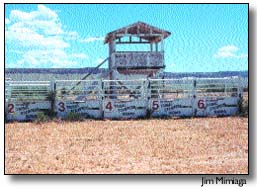|
June 9, 2001
By Jim Mimiaga Four hundred years ago, the Spanish introduction of horses to the seven Ute Indian bands brought a new sense of solidarity to the wide-ranging Rocky Mountain tribe. Today the Ute Mountain tribe plans to revitalize its history of horsemanship with the opening of the long-abandoned Ute Rodeo grounds. Efforts are under way to spruce up the well-built but neglected facility on the Ute Mountain reservation south of Towaoc. "To people here it is a historical site that was known as the best in the area," said Annabelle Talk, one of many Utes volunteering to restore the grounds. "It has been just sitting there since 1988, so my sister said we should all re-open it so our young people can get involved." The grandstands and judging boxes need new paint plus some minor structural work. Volunteers are installing steel-pipe railings and remodeling roping chutes, gates, horse stalls and race courses to get the lighted arena ready for the Ute Mountain Rocky Mountain Rodeo Classic, expected to be held in September. "We’re going to start off small, but in the future we may hold events sanctioned by the Indian Rodeo Association," Talk said. "The community is really excited about it and there have been a lot of donations of materials and labor." The Ute tribe provided $10,000 in start-up funds, and a recent fundraiser brought in another $1,500, Talk said. Time and materials have been donated by Weminuche Construction and the Ute Mountain Casino. Local welders and construction contractors have also chipped in with equipment and materials. The neighboring Navajo tribe, well-known nationally for excelling at and hosting rodeo competitions, has been helping the Utes organize the registration process. Total renovation of the arena, its covered grandstands and rows of livestock stalls would cost around $50,000, organizers estimate. There also plans to install a concessions area, but for now the grounds will be improved enough to host a rodeo soon. "It will be a community event open to anyone interested, not just Utes," Talk said. Standard roping events, barrel-racing, steer-wrestling and a junior rodeo are tentatively planned for the first annual classic. And more traditional Ute activities may be incorporated as well, such as bareback horse-racing and an Indian relay game called Chicken Pickin’. In that game competitors circle a baton stuck in the ground (it was a chicken in the past), and attempt to grab it while riding. A lively relay race then ensues. Before droves of white settlers began arriving in the Southwest in the 19th century, Ute Indians were known as expert horsemen, using their equestrian skills to hunt buffalo, negotiate rugged mountain terrain, and conduct successful warfare and raiding missions against other tribes. Horses allowed the spread-out Ute tribal bands to consolidate into a formidable group that was feared by other tribes, according to historical accounts. Such strength in numbers contributed to a flourishing Ute culture in this region from 1600 to 1850. Their herds of horses and the tribe’s impressive riding skills symbolized the power of the Utes, said Ute culturalist Norman Lopez. "Horse-racing was especially big," Lopez said. "I remember my grandfather was a great racer. The elders were very good at riding bareback, but times have changed. Now all the young people are into cars." Leaders hope to change such attitudes by bringing back a rousing local rodeo facility, Talk said. "Parents are saying that once it’s up and going they are going to sign up their kids right away." |
||
|
Copyright © 2001 the Cortez Journal.
All rights reserved. |
